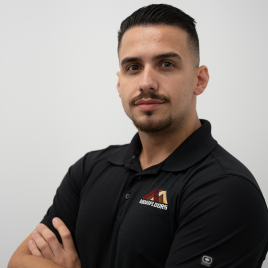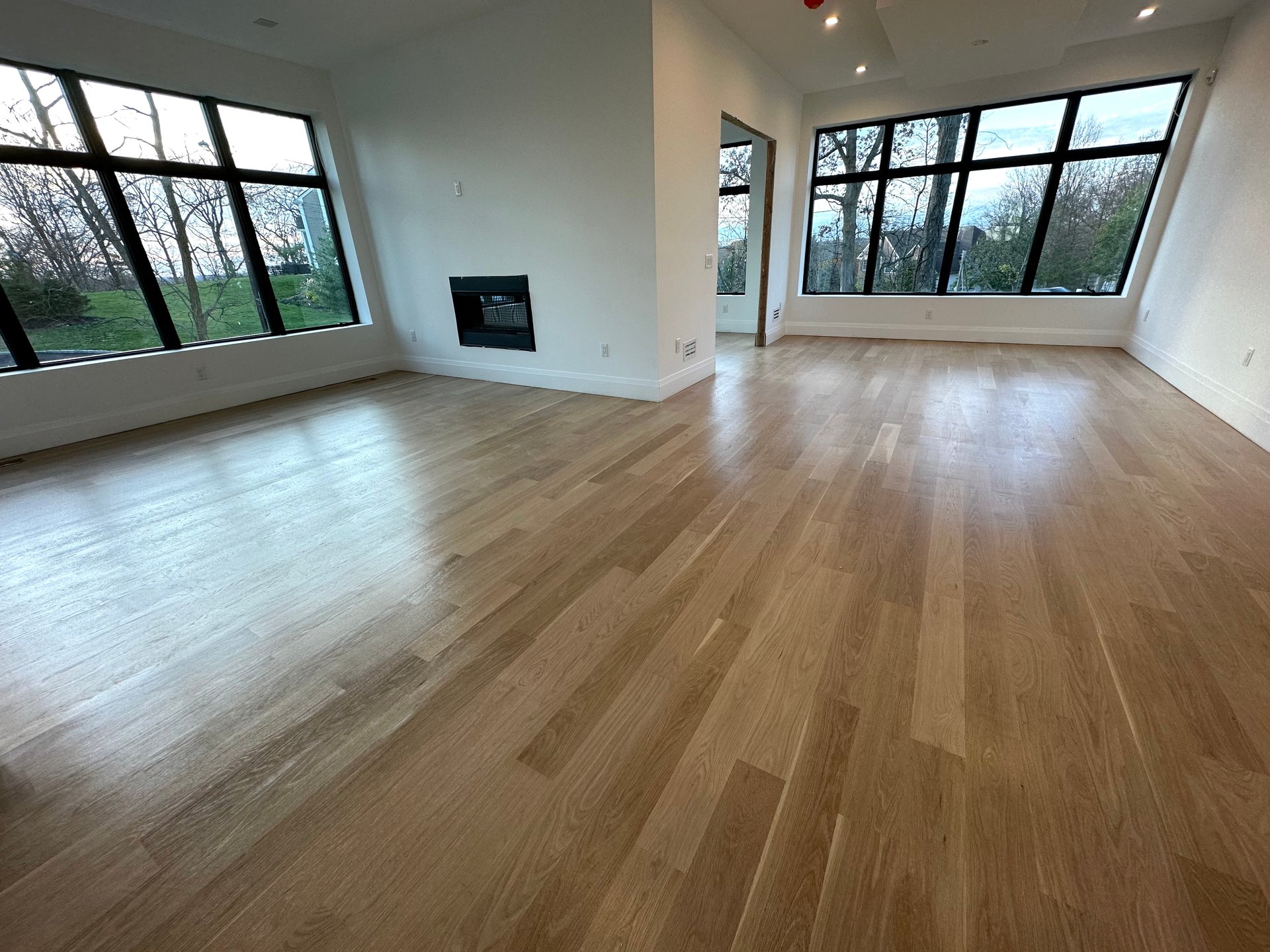.png)
Dustless Sanding vs. Traditional Sanding: Which Hardwood Floor Refinishing Method Is Right for Your New Jersey or New York Home?
When refinishing hardwood floors, the method chosen significantly impacts indoor air quality, project disruption, costs, and lasting beauty. This guide dives into the differences between traditional and dustless sanding, detailing the equipment and containment technologies that set them apart. We’ll connect these differences to what matters most to homeowners—health, timelines, and budget. In urban and suburban settings, where living spaces are often tighter and shared ventilation systems are common, understanding these trade-offs is essential. You’ll discover how each method operates, what to expect in terms of dust production and cleanup, how final finishes compare, and when traditional sanding might still be viable. We’ll also cover how professional providers implement dust containment systems and low VOC finishes, and what questions to ask when seeking a free estimate.
What Is Traditional Hardwood Floor Sanding and How Does It Work?
Traditional hardwood floor sanding is a mechanical process that strips away old finishes and surface imperfections using powerful sanders and abrasive grits to reveal a fresh wood surface. This method primarily employs drum, belt, or orbital sanders for larger areas, along with edgers for tricky edges. The sanding process progresses from coarse to fine grits to smooth and prepare the floor for staining and finishing. However, traditional sanding lacks integrated high-capacity dust capture, producing significant amounts of airborne and settled dust, necessitating extensive containment and manual cleanup. This can extend job duration and increase the risk of cross-contamination within your home.
What Equipment and Materials Are Used in Traditional Sanding?
Traditional sanding employs specialized tools and materials. Drum and belt sanders remove old finishes and level surfaces, while edgers and orbital sanders tackle edges. Abrasive grits range from coarse (e.g., 36–60) to fine (120–150) for a smooth substrate. After sanding, buffers and tack cloths eliminate residual dust before applying oil-based or water-based finishes, with finish choice impacting VOC exposure. Traditional methods generate substantial dust, requiring separate containment barriers and thorough post-job cleaning to minimize dust migration.
What Are the Common Disadvantages of Traditional Floor Sanding?
The main drawbacks of traditional sanding are dust generation, extended cleanup, and potential health or finish quality issues. The process releases significant airborne particulates that settle throughout the home, complicating cleanup and posing risks for individuals with allergies or respiratory conditions. Longer containment and drying times prolong the project and increase indirect costs, such as temporary relocation or additional cleaning.
How Does Dustless Hardwood Floor Sanding Differ from Traditional Methods?
Dustless hardwood floor sanding utilizes high-capacity vacuum systems, containment attachments, and HEPA filtration to capture sanding dust at the source, significantly reducing airborne particulates and visible mess. This technique employs sealed hoses and specialized vacuums—often with multi-stage HEPA filtration—to capture the majority of dust, minimizing its spread and shortening cleanup times. By effectively capturing a high percentage of particulates, occupants experience less respiratory irritation, fewer allergens, and a reduced need for deep cleaning, resulting in a less disruptive overall experience.
What Technology Powers Dustless Sanding and Dust Containment Systems?
Dustless sanding relies on powerful vacuums, sealed containment attachments, and HEPA-grade filters for exceptional dust capture efficiency. Key components include industrial vacuums for continuous dust capture, hose and shroud assemblies that seal at the sanding tool, and multi-stage filtration systems with HEPA elements. Professional systems typically achieve 90-99% capture rates, significantly reducing settled dust and airborne PM2.5 compared to traditional methods, making them ideal for occupied residences and multi-unit buildings.
How Does Dustless Sanding Improve Indoor Air Quality and Health?
By capturing most particulates at the source, dustless sanding greatly reduces airborne dust concentrations and short-term exposure to respirable particles that can trigger asthma and allergies. Lower airborne dust levels decrease the risk of particulates infiltrating HVAC systems and adjacent living spaces, limiting the need for post-job air exchanges or deep cleaning. Combined with low VOC finishes, dust capture further minimizes exposure to volatile organic compounds during curing, enhancing short-term air quality. This makes dustless methods preferred for households with children, elderly, or individuals with respiratory sensitivities.
What Are the Key Differences Between Dustless and Traditional Sanding?
Dustless and traditional sanding methods differ across key attributes: dust production, cleanup time, finish quality, efficiency, project duration, and cost. These distinctions help determine which approach aligns best with homeowner priorities. Dust production is the most noticeable difference, with dustless systems capturing most particulates at the source, while traditional methods disperse more dust. Cleanup time and disruption follow: dustless projects require localized cleaning, whereas traditional sanding necessitates extensive cleanup and may require temporary relocation. Dustless sanding minimizes the risk of dust-related blemishes, resulting in clearer, more durable finishes.
How Do Dust Levels and Cleanup Times Compare?
Dust levels and cleanup times are practical metrics for homeowners, directly relating to health, convenience, and indirect costs. Dustless sanding systems achieve a significant reduction in airborne particulate release (90-99% capture), reducing cleanup to a few hours of localized wiping. Traditional sanding often leaves fine dust throughout the home, necessitating thorough cleaning and sometimes professional HVAC cleaning, which prolongs disruption. Dustless sanding provides a safer, more convenient path to reoccupation for families wishing to stay home.
How Do Efficiency, Project Duration, and Finish Quality Differ?
Efficiency and project duration vary, but dustless systems often reduce total project time by minimizing extensive containment setup and post-job cleaning. While sanding time per square foot may be similar, reduced cleanup and lower rework risk lead to faster overall turnaround for dustless jobs. Finish quality benefits from fewer airborne particulates during coating, reducing surface defects and promoting a smoother, more even cure.
What Are the Cost Implications of Each Sanding Method?
Upfront costs typically favor traditional sanding due to lower equipment and containment costs. However, a comprehensive assessment should consider indirect factors like cleanup, temporary relocation, and potential rework. Dustless sanding carries a higher upfront price due to specialized vacuum and filter systems, but can result in lower total project costs when factoring in reduced downtime, less post-job cleaning, and fewer finish issues.
Why Choose Dustless Sanding: What Are the Benefits for New Jersey and New York Homeowners?
Dustless sanding aligns with the priorities of many New Jersey and New York homeowners—especially those in urban apartments, multi-family buildings, or homes with limited space—by minimizing dust migration, shortening disruption, and promoting healthier indoor air quality. Local housing characteristics and shared ventilation systems make controlling dust spread crucial. Contractors utilizing dust containment systems and HEPA filtration significantly reduce neighbor complaints and HVAC contamination. Combining dustless capture with low VOC finishes lowers particulate and chemical exposures, allowing occupants to return to normal routines sooner.
How Does ModiFloors’ Dust Containment System Enhance Your Refinishing Experience?
At ModiFloors, we implement dust containment systems and low VOC finishes, prioritizing indoor air quality and minimizing disruption for our New Jersey and New York customers. We focus on health benefits by utilizing dust containment systems that capture a high percentage of dust and offering low VOC finishes that reduce chemical exposure. Many customers appreciate the ability to remain in their homes during the process. Our approach reflects a commitment to customer satisfaction, including upfront timelines and free, no-obligation quotes to help plan the job.
What Environmental and Health Advantages Does Dustless Sanding Offer?
Dustless sanding significantly reduces particulate release into the environment. Paired with low VOC finishes, it limits the overall indoor environmental impact of a refinishing project. By capturing most sanding dust, we prevent particulates from entering HVAC systems and escaping into shared outdoor spaces, while low VOC finishes minimize volatile emissions. These benefits are especially relevant in densely populated New Jersey and New York neighborhoods, where outdoor air quality and shared building systems can be affected by renovation work.
When Is Traditional Sanding Still a Suitable Option?
Traditional sanding can be suitable where budget constraints, small isolated repairs, or specific floor conditions make additional capture systems unnecessary or cost-prohibitive. For limited spot repairs, entryway touch-ups, or projects in unoccupied properties where containment is managed externally, traditional methods can yield acceptable results at a lower upfront cost. Some wood floors with significant cupping or crowning may require aggressive mechanical flattening achievable with traditional equipment, though effective containment strategies can still mitigate dust spread.
What Budget or Project Factors Favor Traditional Sanding?
Traditional sanding is often favored when minimizing upfront costs is the primary concern or where dust migration is manageable due to a small area. Common scenarios include small isolated rooms, rental properties between tenants, or projects where owners accept extensive cleaning instead of specialized capture systems. If a contractor offers significantly lower pricing for a traditional approach and the property is vacant, it can be a cost-effective choice.
How to Decide Between Dustless and Traditional Sanding Based on Health Concerns?
When health concerns (asthma, severe allergies, young children, elderly occupants) are present, dustless sanding is typically recommended, as it limits particulate exposure and reduces post-job cleaning. Decision-making should involve questions like: Are sensitive occupants present? Can the household tolerate temporary relocation? Is the property part of a multi-unit building with shared ventilation? If sensitivity is high, prioritize dustless methods and low VOC finishes; if sensitivity is low and the property is vacant, traditional sanding may be considered with appropriate containment.
How Does ModiFloors Ensure Quality and Customer Satisfaction in Hardwood Floor Refinishing?
ModiFloors is dedicated to a customer-centric approach in our sanding and refinishing services, emphasizing quality assurance and clear guarantees for New Jersey and New York homeowners. We highlight a straightforward 4-step process, upfront timelines, free no-obligation quotes, and a solid workmanship guarantee. Our service offerings include Dustless Sanding, Traditional Sanding, Hardwood Floor Refinishing, Installation, Repair, and Commercial Flooring. ModiFloors strives to align methods and materials with project goals, prioritizing minimal disruption and healthier finishes.
What Is ModiFloors’ 4 Step Refinishing Process and Guarantee?
ModiFloors’ 4-step refinishing process guides homeowners from assessment to final inspection, emphasizing clear timelines, dust containment options, and a workmanship guarantee. The initial step provides a free, no-obligation quote outlining the recommended method and timeline. Preparation includes containment and communication about sanding method, followed by sanding and finish application where low VOC finishes are available. The final step involves inspection and activation of the workmanship guarantee.
How Can You Request a Free Estimate for Dustless or Traditional Sanding Services?
Requesting a free estimate is the next step for homeowners exploring dustless and traditional sanding. Gather basic project details for an accurate quote, including approximate square footage, photos of current floor condition, occupant sensitivities (children, pets, allergies), and occupancy plans during work. ModiFloors offers free, no-obligation quotes and upfront timelines, allowing estimators to recommend appropriate dustless containment and low VOC finish options.
Prepare project basics: Measure or estimate square footage and photograph the current floor condition.
Note household constraints: Indicate occupancy plans and any sensitivities to dust or VOCs.
Request a written comparison: Ask for separate line items and timelines for dustless and traditional approaches.




